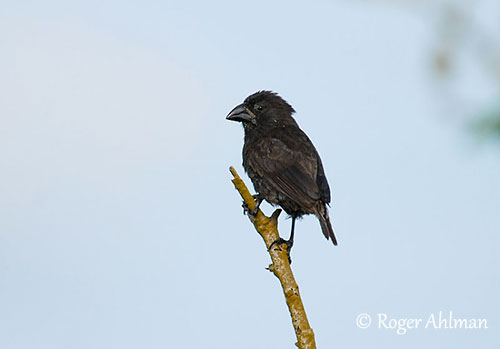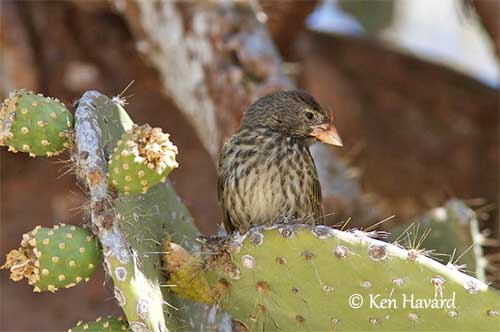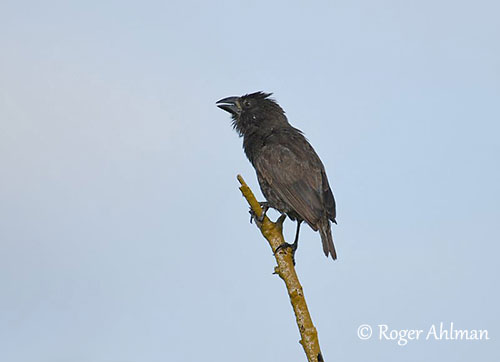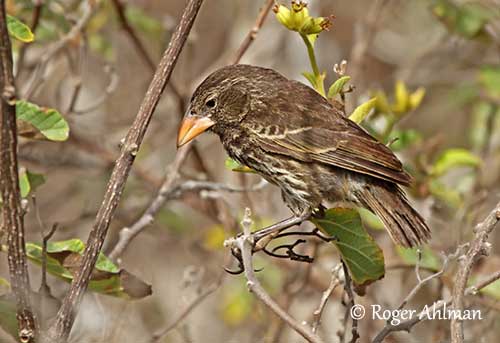
Fr: Géospize voisin
Ang: Genovesa Cactus-Finch
Photographers:
Roger Ahlman
Pbase Galleries Peru and Ecuador
Ken Havard
My Bird Gallery & Flickr gallery 1 & Flickr gallery 2
Text by Nicole Bouglouan
Sources :
HANDBOOK OF THE BIRDS OF THE WORLD Vol 16 by Josep del Hoyo- Andrew Elliot-David Christie – Lynx Edicions – ISBN: 9788496553781
Birds of the Galapagos Archipelago Par Robert Ridgway – Editeur: Рипол Классик, 1897 – ISBN: 5877729659, 9785877729650 – 212 pages
The IUCN Red List of Threatened Species
Neotropical Birds – Cornell Lab of Ornithology
Proposal for English names for recently split Darwin’s finches
Beaks, Adaptation, and Vocal Evolution in Darwin's Finches
Wikipedia, the free encyclopaedia
Home page
Page Passeriforme Order
Darwin’s Finches - Generalities
Genovesa Cactus-Finch
Geospiza propinqua
Passeriformes Order – Thraupidae Family
INTRODUCTION:
The Genovesa Cactus-Finch was formerly a subspecies of the Large Cactus Finch – Geospiza conirostris. It is now a full species only found on Genovesa Island in N Galapagos Islands. It is part of the Darwin’s Finches.
It differs from its former nominate race by some morphological details and the song.
This new species has very restricted range, but the small population is apparently stable. It is currently listed as Vulnerable.

DESCRIPTION OF THE BIRD:
Biometrics: Wing: 3,10 cm – Tail: 1,90 cm – Culmen: 0,85 cm
The Genovesa Cactus-Finch resembles G. conirostris in both size and shape but it has slightly shorter wings.
However, it has narrower bill with more convex culmen terminally. The mandible is more laterally compressed. It has a long bill like the other cactus-finches.
The adult male has black plumage overall, but basally slate-grey. The undertail-coverts are light-buff with a median wedge-shaped mark of black.
The bill is blackish with slightly dark horn grey mandibles of practically similar width.
Legs and feet are dusky.
The female is paler, with paler streaks than in G. conirostris. The bill colour may change according to the season.

RANGE:
The Genovesa Cactus-Finch is restricted to Genovesa Island, in N Galapagos Islands (Tower Island).
HABITAT:
The Genovesa Cactus-Finch frequents dry shrubland and arid lowland areas where it can find the cactus Opuntia.
CALLS AND SONGS:
Genovesa Cactus-Finch and Large Cactus Finch have different songs.
From several studies and observations, these differences are partially caused by the narrower, more laterally compressed bill of G. propinqua. The bill shape can influence the vocal evolution of the bird, and may lead to particularly pronounced variations in song structure.

BEHAVIOUR IN THE WILD:
The Genovesa Cactus-Finch feeds mainly on Cactus Opuntia helleri. It takes pulp, flowers and fruits of the plant. In addition, it catches insects eating nectar on the flowers.
It probably feeds on seeds too, especially outside the breeding season.
The reproduction is closely related to rainfalls.
These birds are monogamous. The male sings to attract females, and it is usually territorial.
The Genovesa Cactus-Finch is resident on Genovesa Island. It only performs short-distance flights, because its short wings do not allow long-distance movements.

REPRODUCTION OF THIS SPECIES:
The breeding season takes place during the rainfalls, and mainly from January to May.
We don’t know the breeding behaviour of this new species, but we can suggest that it is similar to G. conirostris.
The nest is spherical and made with dry grasses. It is placed in cactus or in bush.
The chicks are fed by both parents and fledge about two weeks after hatching.
PROTECTION / THREATS / STATUS:
The Genovesa Cactus-Finch has very restricted range and small population, roughly estimated at less than 1,000 mature individuals. However, this population is apparently stable.
This species is threatened by invasive predators and diseases, due to the small population.
The Genovesa Cactus-Finch is currently listed as Vulnerable.
